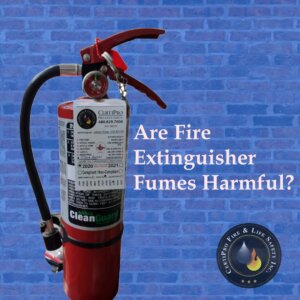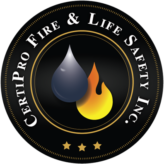 ‘Are fire extinguisher fumes harmful?’ is an odd question because it seems counterintuitive. Fire extinguishers are meant to be helpful devices, but many homeowners often wonder if the fumes and white substance that are projected are safe to be around. In this article, we discuss the truth behind fire extinguisher powder and whether it is safe enough to have in your home.
‘Are fire extinguisher fumes harmful?’ is an odd question because it seems counterintuitive. Fire extinguishers are meant to be helpful devices, but many homeowners often wonder if the fumes and white substance that are projected are safe to be around. In this article, we discuss the truth behind fire extinguisher powder and whether it is safe enough to have in your home.
Rumor has it that fire extinguisher fumes are toxic and harmful. As a result, some building owners are skeptical of owning one. However, we must dig deeper to uncover the truth about these supposed safety devices.
What is Inside Fire Extinguishers?
Something can be either harmful or useful depending on it’s components and application. For example, milk can trigger allergies due to the alpha S1-casein that it contains. Fire is hot because it releases thermal energy. The same can be said for fire extinguisher material.
When you spray a fire extinguisher, you may see foam or fumes coming out of it. These fumes are made of 2 different ingredients:
- Nitrogen.
The most common fire extinguisher ingredient is nitrogen. Nitrogen usually pairs with a dry chemical extinguisher. If you have a stored pressure fire extinguisher, chances are you are using nitrogen to put out the fire. - Carbon dioxide.
If you own a cartridge-operated extinguisher, you are not using nitrogen. You are using carbon dioxide. Unlike nitrogen, carbon dioxide in fire extinguishers is not common.This extinguisher has the advantage of being able to be discharged, recharged, and returned faster than nitrogen types. Thus, carbon dioxide extinguishers are great for frequent use. Industrial facilities are the perfect example.
Although fumes are associated with fire extinguishers, this is not always true. There is a fire extinguisher that uses neither nitrogen nor carbon dioxide – a water extinguisher. Given the resemblance to its name, a water-based extinguisher contains water.
You’ve probably guessed that a water-based extinguisher is environmentally friendly and cheap. This is correct. However, water-based extinguishers are only effective for class A fires, meaning you can only use them to put out fire on wood, plastic, cloth, and rubber.
Are Fire Extinguisher Fumes Harmful?
Can fumes from fire extinguishers kill you? The answer is yes and no.
Earlier we described how a fire extinguisher releases fumes. What we have not yet told you is the fumes contain mono ammonium phosphate. However, some fumes may contain baking soda (sodium bicarbonate) instead. You can tell whether a fume contains monoammonium phosphate (MAP) or baking soda by its color.
A yellow fume contains MAP, and a white fume contains baking soda. Either way, the fume might be dangerous if handled incorrectly.
If you inhale MAP or baking soda, your body reacts negatively. You might feel mild nose irritation, headache, and shortness of breath. On top of that, some people who deliberately inhale fume experience ongoing irritation, pneumonia, seizures, irregular heartbeat, and kidney failure.
Fortunately, it’s possible to resolve minor symptoms quickly. All you need is fresh air. However, serious symptoms require major care. Steam treatment and medical assistance may have to be involved.
Fumes can be safe for humans. Both minor and major symptoms only occur if you inhale them. As long as you know how to safely use a fire extinguisher, the benefits outweigh the risks.
How to Use a Fire Extinguisher Safely
The fire extinguisher is your best chance to escape property damage or the chance of burning to death. It is your ‘friend’ if you use it right. Here are 3 tips to ensure you are using the fire extinguisher safely:
- Choose The Perfect Extinguisher Type.
Everyone knows fire can cause property damage. But no fire accidents are the same. In fact, there are several classes of fire: Class A, B, C, D, and K.
First, Class A is the least harmful. Class A ignitions are wood, paper, cloth, rubber, and plastic.
Second, Class B triggers are flammable liquid. Fire starting with gas, stoves, or cigarette lighters fall into class B.
Class C and D are the dangerous ones. Class C are fire triggers due to electrical components. Cable failure is the perfect example. On the other end of the spectrum, class D fire causes are magnesium, titanium, or lithium. Unless you are working in a certain industry, you will not encounter class D.
Lastly, Class K is the deadly one. Class K fire is ignited by grease in a commercial kitchen. You may face class K fire if you have left enough grease all over your home kitchen. Class K fire spreads quickly. You must be alert if it happens.
You cannot use the same fire extinguisher for all classes. The nitrogen-based fire extinguisher, for example, can put out class A, B, and C fires. Nevertheless, nitrogen-based fire extinguishers fail to put out classes D and K.
That being said, you must choose your fire extinguisher according to your needs.
- Use Your Fire Extinguisher Properly
You must take fire safety briefings seriously. A fire safety briefing usually involves learning how to use a fire extinguisher properly – especially how to make sure you are at a perfect distance between the fire and extinguisher.
The majority of extinguishers require you to stand 8 feet away from the fire. This is because, if you stand too close, you might get burned. We obviously wouldn’t want that to happen.
Another reason to keep 8 feet distance between yourself and the heat source is the fire spread. Your extinguisher can actually spread the flame if you are too close. So, make sure you keep this in mind if you ever have to put out a fire.
An automatic fire extinguisher is a different story. Since automatic fire extinguishers work automatically, you do not have to worry about technicality. All you have to do is escape the building.
- Perform Regular Maintenance.
There is one thing in common when it comes to fire extinguishers. You are advised to perform regular maintenance on them.
A fire extinguisher maintenance starts by checking it regularly. Your fire extinguisher must be certified and inspected annually. On top of that, you are advised to do monthly documentation and a complete internal breakdown once every 6 years.
As a home or building owner, you are advised not to perform an inspection yourself. Unless you are trained and certified, you might endanger yourself. One recklessness can lead to property loss or life. It is best to leave it to a professional.
You already know the basics of how to safely utilize fire extinguishers. Still, fire extinguisher maintenance, inspection, and installation is not easy. Luckily for you, CertiPro Fire is here to help.
CertiPro Fire is a fire extinguisher, system, and safety expert in Mesa, Arizona certified and trained professionals. Call now at +1 480 829 7600 or click here to request a quote or to have your fire extinguisher tested and inspected.
